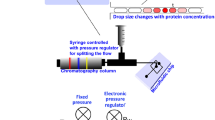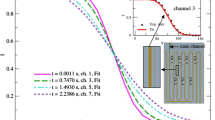Abstract
Spectrophotometric procedure is a traditional method for quantifying protein concentration in solution. The benefit of this method is simple and direct, not requiring standard materials, sample incubation, and exogenous chromophore addition. There are also some drawbacks, low detection limits and high amounts of protein needed. The recent advances in fiber optics and nano-technology enable to overcome those drawbacks by using microvolume sampling and extremely short pathlengths. In this study, the utility of the microvolume system with microfluidic carriers was assessed for concentration measurement of biopharmaceutical protein using absorbance at 280 nm and also compared to a traditional instrument. The results show a high correlation of estimation by Cohen’s d effect size and Pearson correlation coefficient between two different spectrometers. For UV spectral analysis, there are no statistically significant difference between those spectra from a microvolume spectrometer and a traditional one. For the extinction coefficient determination, two different spectrometers also give quite comparable and similar values. Thus a microvolume spectrometer can be used as an alternative over a traditional one to determine the concentration of biopharmaceutical protein. Moreover, the dynamic range for protein quantification by a microvolume spectrometer is over 10-fold higher than that of a traditional one.
Similar content being viewed by others
References
Song, K.E. et al. Structural identification of modified amino acids on the interface between EPO and its receptor from EPO BRP, human recombinant erythropoietin by LC/MS analysis. Mol. Cells. 37, 819–826 (2014).
Byeon, J., Choi Y.J. & Suh J.K. Structural Characterization of Modification on the Interface between a Ligand and its Receptor for Biopharmaceuticals. Receptors Clin. Investig. 2, 1–5 (2014).
Greer, F., Reason, A. & Rogers, M. Post-translational modifications of biopharmaceuticals-a challenge for analytical characterisation. European BioPharm. Rev. 106-111 (2002).
Walsh, G. Post-translational modifications of protein biopharmaceuticals. Drug Discov. Today 15, 773–780 (2010).
Diepold, K. et al. Simultaneous assessment of Asp isomerization and Asn deamidation in recombinant antibodies by LC-MS following incubation at elevated temperatures. PLoS One 7, e30295 (2012).
Warburg, O. & Christian, W. Insulation and crystalisation of the Fermenting process of enolase. Biochem. Z. 310, 384–421 (1942).
Layne, E. Spectrophotometric and turbidimetric methods for measuring proteins. Methods Enzymol. 3, 447–454 (1957).
Grimsley, G.R. & Pace C.N. Spectrophotometric determination of protein concentration. Curr. Protoc. Protein Sci. 33, 3.1.1–3.1.9 (2004).
Pace, C.N., Vajdos, F., Fee, L., Grimsley, G. & Gray, T. How to measure and predict the molar absorption coefficient of a protein. Prot. Sci. 4, 2411–2423 (1995).
Bradford, M.M. A rapid and sensitive method for the quantitation of microgram quantities of protein utilizing the principle of protein dye binding. Anal. Biochem. 72, 248–254 (1976).
Lowry, O.H., Rosebrough, N.J., Farr, A.L. & Randall, R.J. Protein measurement with the Folin phenol reagent. J. Biol. Chem. 193, 265–275 (1951).
Desjardins, P., Hansen, J.B. & Allen, M. Microvolume spectrophotometric and fluorometric determination of protein concentration. Curr. Protoc. Protein Sci. 55, 3.10.1–3.10.16 (2009).
Pace, C.N. & Schmid, F.X. How to determine the molar absorbance coefficient of a protein. In Protein Structure: A Practical Approach, T.E. Creighton, eds. (Oxford, UK: IRL Press), 253–259 (1997).
Sittampalam, G.S., Ellis, R.M., Miner, D.J., Rickard, E.C. & Clodfelter, D.K. Evaluation of Amino Acid Analysis as Reference Method to Quantitate Highly Purified Proteins. J. Assoc. Offic. Anal. Chem. 71, 833–838 (1988).
Juris, O. Amino acid analysis. Methods Enzymol. 182, 587–601 (1990).
Dunn, B. Quantitative amino acid analysis. Curr. Protoc. Mol. Biol. 76, 10.1B (2006).
Anders, J.C., Parten, B.F., Petrie, G.E., Marlowe, R.L. & McEntire, J.E. Using amino acid analysis to determine absorptivity constants: A validation case study using bovine serum albumin. BioPharm Int. 2, 30–37 (2003).
Gill, S.C. & Hippel, P.H. Calculation of protein extinction coefficients from amino acid sequence data. Anal. Biochem. 182, 319–326 (1989).
Author information
Authors and Affiliations
Corresponding author
Rights and permissions
About this article
Cite this article
Byeon, J., Kang, K.H., Jung, HK. et al. Assessment for quantification of biopharmaceutical protein using a microvolume spectrometer on microfluidic slides. BioChip J 11, 21–29 (2017). https://doi.org/10.1007/s13206-016-1104-9
Received:
Accepted:
Published:
Issue Date:
DOI: https://doi.org/10.1007/s13206-016-1104-9




